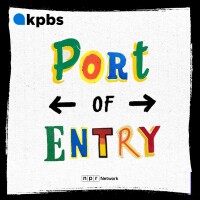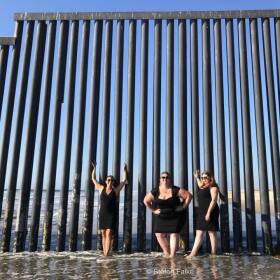Port of Entry

These are cross-border stories that connect us. Border people often inhabit this in-between place. From KPBS and California Humanities, “Port of Entry” tells personal stories from this place — stories of love, hope, struggle, and survival from border crossers, fronterizxs, and other people whose lives are shaped around the wall. Rooted in San Diego and Tijuana, we are a transborder podcast for transborder people. We live life on la linea.
Have you checked out our podcast in Spanish? If so, Take our survey.
¿Hás escuchado nuestro podcast en Español? Participa en nuestra encuesta.
Ways To Subscribe
-
Today we're tracing the story of how Latin music became as popular as American pop music, all through the eyes of Isabela Raygoza. Isabela is a music journalist from Tijuana and San Diego whose career very closely paralleled the boom in Latin music that's happened over the past decade. Back in the day, when Latin stars wanted to cross over into pop music, they would have to start singing in English. Nowadays, you have music icons crossing over the other way: singing in Spanish. About the Show: “Only Here” is about the unexplored subcultures, creativity and struggles at the U.S.-Mexico border. The KPBS podcast tells personal stories from people whose lives are shaped by the tension reverberating around the wall. This is a show for border babies, urban explorers or those who wonder what happens when two cultures are both separated and intertwined. Follow Us: https://www.facebook.com/onlyherepodcast/ https://www.instagram.com/onlyherepodcast/ Support Us: https://www.kpbs.org/donate Give us Feedback: 619-452-0228 podcasts@kpbs.org
-
Ruffo Ibarra Arellano is a pedigreed chef. With his resume, he could be working at some of the fanciest Michelin-star restaurants in the world. But he chose to be here, running a restaurant in Tijuana instead. Because Ruffo loves his roots. And he wants his food to be infused with them. Obviously, the coronavirus pandemic is deeply impacting Ruffo’s work and his restaurant. It’s impacting all of us. But restaurants are being hit particularly hard. Ruffo’s team had just finished remodeling the restaurant a couple of weeks before the quarantine became the new normal. Even as many restaurants layoff a lot of their staff, though, Ruffo and his partners have assured their team that they have their backs. They’re committed to their safety and well being, even if that means taking a big financial hit. Who we are: Hosted by Alan Lilienthal Produced by Kinsee Morlan Sound design by Emily Jankowski Follow Us: https://www.facebook.com/onlyherepodcast/ https://www.instagram.com/onlyherepodcast/ Support Us: https://www.kpbs.org/donate Give us Feedback: 619-452-0228 podcasts@kpbs.org Photo: A picture of Ruffo Ibarra Arellano
-
Dulce Garcia is undocumented, but her status has mostly fueled her ambition, not stifled it. Dulce’s an immigration lawyer. And she’s recently become one of the most high profile immigrant advocates working on the border today.
-
We know what’s on your mind right now: the coronavirus. And we know you, our cross-border audience, you’ve probably got one big question completely dominating your brainwaves: will our border close? Or, when our border closes, what exactly will happen? So, we’re gonna hit the pause button on our normal programming and bring you some news you can use right now. Max Rivlin-Nadler covers the border for KPBS. Max gives us the most up-to-date information he has as of recording time: 1:30 p.m. Thursday, March 12.
-
Telefónica Gastro Park has grown into one of the most popular destinations for both locals and tourists in Tijuana. We continue our conversation-style episodes with Antonio Gamboa, the founder of the foodie hot spot, which has always attracted a big cross-border crowd. Antonio describes how his parking lot filled with food trucks sprouted organically and eventually grew into the sophisticated collection of food trucks, beer, wine, art and coffee that it is now. He also breaks a bit of food news: he's currently working on opening Telefónica Norte in San Diego. Telefónica Gastro Park info: http://telefonicagastropark.com/en/ About the Show: “Only Here” is about the unexplored subcultures, creativity and struggles at the U.S.-Mexico border. The KPBS podcast tells personal stories from people whose lives are shaped by the tension reverberating around the wall. This is a show for border babies, urban explorers or those who wonder what happens when two cultures are both separated and intertwined. Who we are: Hosted by Alan Lilienthal Produced by Kinsee Morlan Sound design by Emily Jankowski Follow Us: https://www.facebook.com/onlyherepodcast/ https://www.instagram.com/onlyherepodcast/ Support Us: https://www.kpbs.org/donate Give us Feedback: 619-452-0228 podcasts@kpbs.org Photo: A picture of food from Telefónica Gastro Park.
-
In a new episode of KPBS' border podcast "Only Here," we continue our series on border art with a mural that's broadcasting the voices of deportees and those commonly known as DREAMers, children brought to the U.S. illegally as children. From heart-wrenching stories about parents being deported and separated from their kids to first-hand accounts of what it’s like to start a new life in a new country, the mural painted on the actual border fence uses technology to share stories of deportation and struggle. You can hear the stories when you walk up to the mural in Playas de Tijuana. It's painted on the actual border fence, and you can use your phone to scan black-and-white QR codes printed on little stickers stuck to the mural. Scanning the stickers takes you to YouTube videos. The stories you'll hear in the videos are from two digital storytelling archives: Humanizing Deportation: http://humanizandoladeportacion.ucdavis.edu/en/ Dacamented: https://dacamentedarchive.com/ The Playas de Tijuana Mural Project is by artist, scholar and activist Lizbeth De La Cruz Santana. More about the project here: https://lizbethdelacruzsantana.com/mural-project About the Show: “Only Here” is about the unexplored subcultures, creativity and struggles at the U.S.-Mexico border. The KPBS podcast tells personal stories from people whose lives are shaped by the tension reverberating around the wall. This is a show for border babies, urban explorers or those who wonder what happens when two cultures are both separated and intertwined. Who we are: Hosted by Alan Lilienthal Produced by Kinsee Morlan Sound design by Emily Jankowski Follow Us: https://www.facebook.com/onlyherepodcast/ https://www.instagram.com/onlyherepodcast/ Support Us: https://www.kpbs.org/donate Give us Feedback: 619-452-0228 podcasts@kpbs.org Photo: A picture of the mural by Alan Lilienthal.
-
We’ve got something new for listeners. In addition to our long-form, deep dive episodes, we’re going to try something new by sprinkling in more low-key, casual conversations with interesting people who live cross-border lives. You'll know it's happening when you see the word "conversation" in the title of the episode. To be honest, the highly produced episodes you’re used to hearing take a lot of time. Between field recordings, research, sound design and writing, it’s just a ton of work. We had to come up with a way to give our small team more time between new episodes so we can get even better at telling these longer, more nuanced stories. So that’s why we’re doing these conversations -- to give ourselves the time we need to make the best show possible. So, in this new conversation series, we’re going to talk to creatives, entrepreneurs, influencers- anyone that embodies our binational region and can help us get to know it a little better. We’re going to start this week with the greatest food in the world — tacos. We all love tacos and Tijuana has arguably some of the best in all of Mexico. Scott Koenig is always on the hunt for the best tacos in TJ. He's the writer behind the travel website “A Gringo In Mexico." Koenig has also written a book called “Seven Days in The Valle: Baja California’s Wine Country Cuisine” and he writes columns about food in Baja for several local publications. We talk to Scott about living in the moment, immigration's wonderful effect on food and his outsider's take on tacos in Tijuana. He gives us a quick list of a few good taco shops in Tijuana and the tacos to try at each one. Tacos Birria Martin: Tacos Fitos, Xolotacos https://www.facebook.com/Tacos-de-birria-Martin-178106339200263/ Mariscos Walter: Mariscos Ruben, Mariscos Mazateño https://www.facebook.com/mariscoswalter2005/ Tacos Chuy, Tacos El Vaquero, Tacos Don Esteban https://www.facebook.com/tacos.chuyjuarez/ About the Show: “Only Here” is about the unexplored subcultures, creativity and struggles at the U.S.-Mexico border. The KPBS podcast tells personal stories from people whose lives are shaped by the tension reverberating around the wall. This is a show for border babies, urban explorers or those who wonder what happens when two cultures are both separated and intertwined. Follow Us: https://www.facebook.com/onlyherepodcast/ https://www.instagram.com/onlyherepodcast/ Support Us: https://www.kpbs.org/donate Give us Feedback: 619-452-0228 podcasts@kpbs.org Photo: Tacos de Birria de Res with Tuetáno (Beef Bone Marrow) at Xolotacos Otay
-
The line of cars and people waiting to cross the San Ysidro Port of Entry is so big — so long — it’s got its own gravitational pull. It’s created this whole world of its own, an ecosystem that swirls all around it. A shorter line would be a thing of beauty. The long line is actually a problem that the federal governments and local business leaders on both sides of the border are trying to solve. Because the border equals money. In this episode, we bring you sounds from the border line, then take you to the Border Innovation Challenge at UC San Diego. After that, we introduce you to Cheslav Versky, a tech entrepreneur who won the Border Innovation Challenge and is now working on installing a system that would collect detailed border-crossing data at a level it's never been collected before.
-
We wanted to take a minute or two to tell y’all about some exciting developments for the Only Here podcast team. We were recently selected to be part of a prestigious podcast accelerator program that’s pushing us to experiment, take risks and step outside of our creative comfort zones when it comes to this show. We were one of just six public media stations from across the country chosen to be a part of a grant program called Project Catapult. We’re suuuper excited and honored to be a part of it. Project Catapult is basically a training that takes our Only Here production team to Boston once a month where we learn from a team of experts from PRX and other public media stations. PRX, by the way, is kinda on par with NPR...it’s a public media company that distributes a long list of podcast and broadcast shows that include some of the most popular in the world -- like This American Life and The Moth. We are learning soooo much from PRX! And one of the most important things we’ve learned is to think a looooot more about you -- our audience. So, here we are, asking you listeners to do us a big, big favor and email us at podcasts@kpbs.org to tell us more about who you are, why you listen to the show and anything else you want us to know. Maybe there’s a person, place or thing you want us to cover -- we’re open to anything and everything. So, help us make our PRX teachers proud, and please shoot us an email and tell us who you are and what you think of our show. Thanks in advance.
-
Anishka Lee-Skorepa wants to break cultural barriers surrounding both the border and opera music. The San Diego opera singer is part of Artistas Fronterizas, a group that works to paint a clearer picture of border life through performances in places where opera doesn't normally go. Our series of episodes focused on border art continues with a story about an opera singer who’s painting a clearer picture of border culture through song.
Alan Lilienthal is a musician and the co-host of “Port of Entry,” a KPBS podcast about cross-border culture and the people who shape it. His life’s mission is to melt borders and celebrate our shared humanity through art.
Natalie Gonzalez is the co-host of ‘’Port of Entry” — a KPBS podcast. The podcast covers stories about cross-border people whose lives have been shaped by Tijuana and San Diego. Natalie is also a theater actress from Tijuana Hace Teatro. She studied at Universidad Iberoamericana in Tijuana where she graduated from Communications and Media School.

This project was made possible in part with support from California Humanities, a non-profit partner of the National Endowment for the Humanities. Visit calhum.org.












